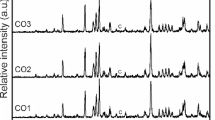Abstract
In present work, CuZr4(PO4)6, which is a complex phosphate of NASICON family, has been characterised as ceramic pigment. To this purpose, its thermal stability, colour properties and some other important pigment characteristics were studied. In order to obtain pure phase ceramic powder of CuZr4(PO4)6, several synthesis approaches were attempted. The thermal transformations in the reaction mixtures were investigated by DTA-TG and XRD analysis. Thermal stability of the obtained products was studied using heating microscopy, DTA-TG and XRD analysis. Colouring performance and lightfastness of CuZr4(PO4)6 were tested within commercial ceramic glazes, and its colour in powder and glaze is described by means of CIELAB and CIELCh systems. It is shown that CuZr4(PO4)6 ceramic powder has sufficient thermal stability and attractive colouring properties to be used as ceramic pigment.








Similar content being viewed by others
References
Pet’kov V, Kurazhkovskaya VS, Orlova A, Spiridonova ML. Synthesis and crystal chemical characteristics of the structure of M0.5Zr2(PO4)3 phosphates. Cryst Chem. 2002;47:802–9.
Oikonomou P, Dedeloudis C, Stournaras CJ, Ftikos C. [NZP]: a new family of ceramics with low thermal expansion and tunable properties. J Eur Ceram Soc. 2007;27:1253–6.
Goodenough JB, Hong HYP, Kafalas JA. Fast Na+-ion transport in skeleton structures. Mater Res Bull. 1976;11:203–20.
Scheetz BE, Agrawal DK, Breval E, Roy R. Sodium zirconium phosphate (NZP) as a host structure for nuclear waste immobilization: a review. Waste Manag. 1994;14(6):489–505.
Shchelokov I, Asabina E, Sukhanov M, Ermilova M, Orekhova N, Pet’kov V, Tereshchenko G. Synthesis, surface properties and catalytic activity of phosphates Cu0.5(y+1)FeyZr2–y(PO4)3 in methanol conversion. Solid State Sci. 2008;10:513–7.
Serghini A, Brochu R, Ziyad M, Vedrine JC. Synthesis, characterisation and catalytic behaviour of Cu0.5M2(PO4)3 (M = Zr, Sn, Ti). J Alloys Compd. 1992;188:60–4.
Ermilova MM, Sukhanov MV, Borisov RS, Orekhova NV, Pet’kov VI, Novikova SA, Il’in AB, Yaroslavtsev AB. Synthesis of the new framework phosphates and their catalytic activity in ethanol conversion into hydrocarbons. Catal Today. 2012;193:37–41.
Komarneni S, Gould WW, inventors; The Penn State Research Foundation, assignee. High stability transition metal NZP type phosphates. United States patent US 006387832B1. 2002 May 14.
Gorodylova N, Kosinová V, Dohnalová Ž, Bělina P, Šulcová P. New purple-blue ceramic pigments based on CoZr4(PO4)6. Dyes Pigm. 2013;98:393–404.
Gorodylova N, Kosinová V, Šulcová P, Bělina P, Vlček M. Cr1/3Zr2P3O12 with unusual tetrahedral coordination of Cr(III): peculiarities of the formation, thermal stability and application as a pigment. Dalton Trans. 2014;43(41):15439–49.
Gorodylova N, Šulcová P, Bosacka M, Filipek E, Vlček M. Heterovalent Zr4+-Cu2+ substitution in zirconium pyrophosphate: from theoretical models to synthesis and utilization. J Eur Ceram Soc. 2015;35:4293–305.
Bussereau I, Olazcuaga R, Le Flem G, Hagenmuller P. Synthesis and properties of a new variety of Cu0.5Zr2(PO4)3 obtained by sol–gel technique. Eur J Solid State Inorg Chem. 1989;26:383–99.
Trojan M, Šulcová P. Binary Cu(II)–Mn(II) cyclo-tetraphosphates. Dyes Pigm. 2000;47:291–4.
Trojan M, Beneš L. Binary cyclo-tetraphosphates Cu2−xMgxP4O12. Mater Lett. 1989;8:324–8.
Taoufik I, Haddad M, Brochu R, Berger R. Location of Cu2+ ions in some protoned Nasicon-type phosphates. J Mater Sci. 1999;34:2943–7.
Taoufic I, Haddad M, Nadiri A, Brochu R, Berger R. X and Q band EPR studies of Cu0.5Zr2(PO4)3 phosphates. J Phys Chem Solids. 1999;60:701–7.
Christiansen RHW, Warner TE. A study of copper stoichiometry and phase relationships in the copper-zirconium phosphate system: CuZr2(PO4)3–Cu0.5Zr2(PO4)3. J Mater Sci. 2006;41:1197–205.
Kazakos-Kijowski A, Komarneni S, Agrawal D, Roy R. Synthesis, crystal data and thermal stability of magnesium zirconium phosphate [MgZr4(PO4)6]. Mater Res Bull. 1988;23:1177–84.
Chen F, Shen Q, Schoenung JM, Zhang L. Synthesis and pressureless sintering of zirconium phosphate ceramics. J Am Ceram Soc. 2008;91(10):3173–80.
Tena MA. Characterization of MgxM2−xP2O7 (M=Cu and Ni) solid solutions. J Eur Ceram Soc. 2012;32:389–97.
Author information
Authors and Affiliations
Corresponding author
Rights and permissions
About this article
Cite this article
Gorodylova, N., Kosinová, V., Dohnalová, Ž. et al. Thermal stability and colour properties of CuZr4(PO4)6 . J Therm Anal Calorim 126, 121–128 (2016). https://doi.org/10.1007/s10973-016-5415-9
Received:
Accepted:
Published:
Issue Date:
DOI: https://doi.org/10.1007/s10973-016-5415-9




